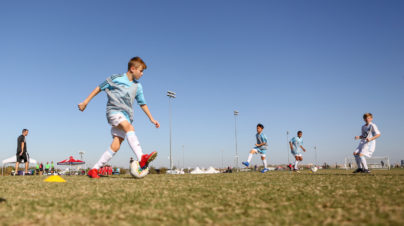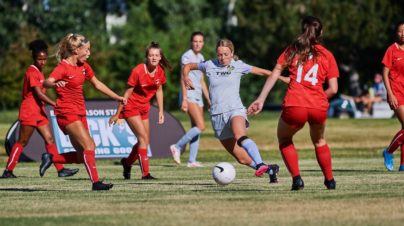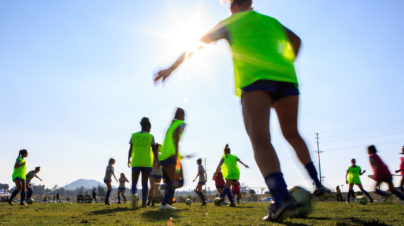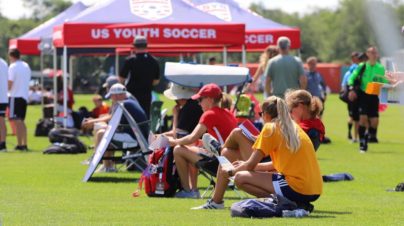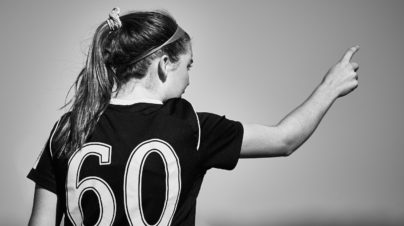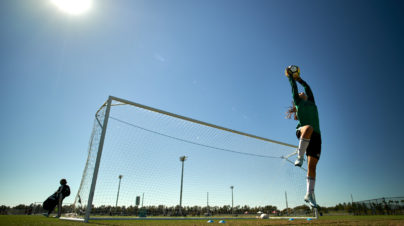A Guide to Building Youth Soccer Soccer Skills at Every Age
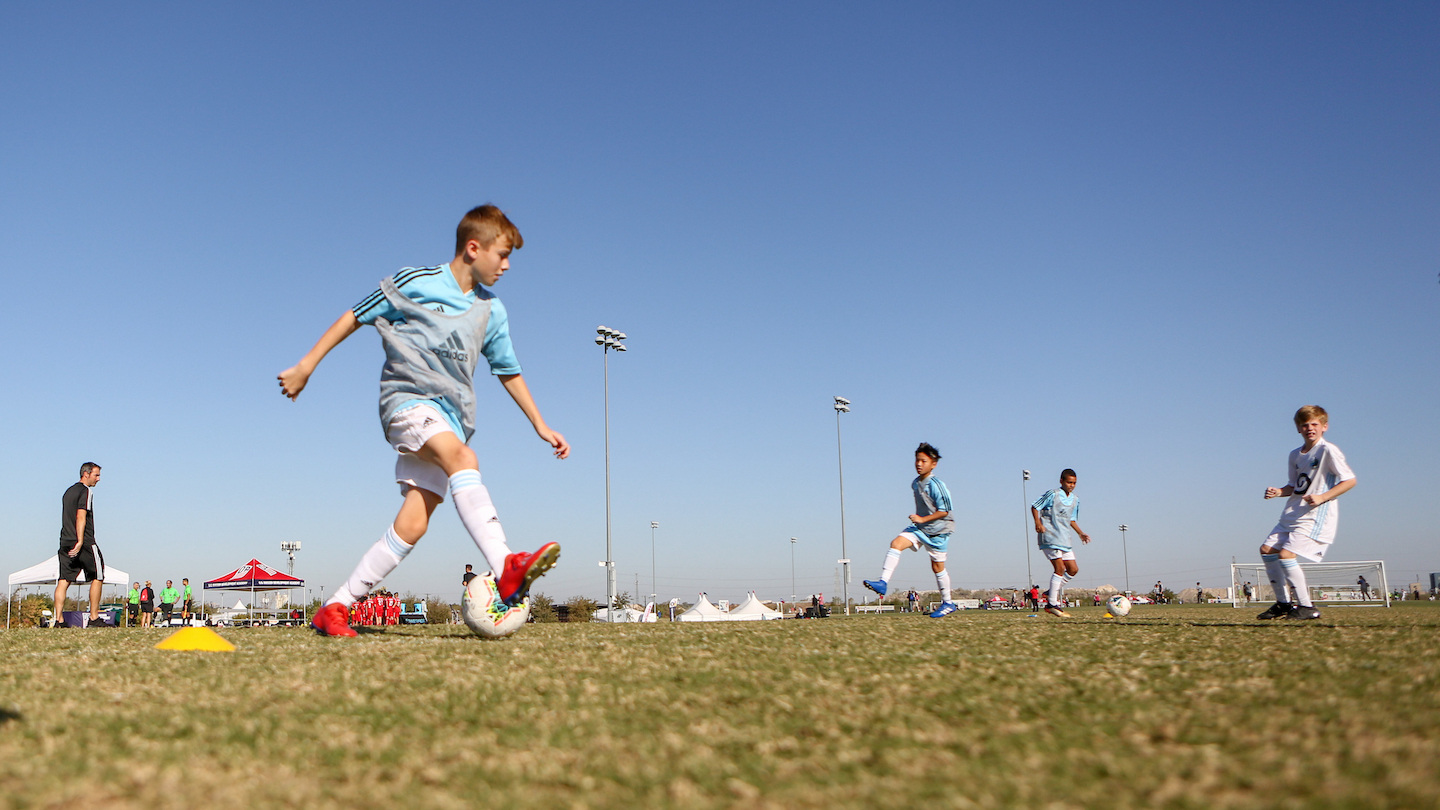
 Co-Published on SoccerStars.com. To learn more about the Soccer Stars organization, click here.
Co-Published on SoccerStars.com. To learn more about the Soccer Stars organization, click here.
Soccer is not only a great way to boost the physical development of children, but also an opportunity to help them learn valuable life skills such as social networking, problem-solving, and decision-making. Kids can play soccer at virtually any age, although it is important for each age group to approach it appropriately. Even toddlers ages 12 to 24 months can get a head start on honing their skills
At each stage, the skills kids develop in soccer prepare them to succeed when they enter the next stage. The same could be said about the life skills that soccer imparts.
How Soccer Can Help Young Players Develop Life Skills
As mentioned, soccer can help kids develop a wide range of life skills. These skills include, but are not limited to:
- Self-confidence;
- Social confidence;
- Communication;
- Conflict resolution;
- Collaboration;
- Empathy;
- Relationship management;
- Work ethic;
- Time management;
- Goal setting;
- Emotional management;
- Health management;
- Work-life balance.
For this reason, youth soccer is a valuable development tool that goes even beyond skills specifically related to sports strategy.
Major Skill Groups
There are four major skills groups that you can develop in soccer:
- Technique: Technique refers to the basic movements and movement strategies that sports players develop. Technique is usually developed through drills to make the movements second nature. These optimized movements are meant to not only improve performance, but also to reduce fatigue and risk of injury.
- Game intelligence: Game intelligence, also known as tactical awareness, refers to how well a player understands the larger dynamics of the game. With good game intelligence, a player can analyze gameplay from a perspective beyond their own designated role. Using this information, a player can adjust their personal strategy to better suit each specific situation.
- Physical fitness: Physical fitness is the process of ensuring that your body is strong and healthy enough to support the physical work that you are putting in. Good physical fitness can not only improve your performance, but also reduce the risk of injury. Ideally, physical fitness should be approached with both the short-term and the long-term in mind.
- Mindset: Mindset refers to your attitude and mental fortitude. Developing a healthy mindset for sports is important because without the proper mindset to support your skills, your performance is likely to suffer. Ideally, young soccer players should develop a determined and positive mindset that will allow them to maintain confidence and remain calm and resilient under pressure.
Any more specific skills that you develop will fall under one of these four categories.
Activities and Exercises for Young Players
Because players in different age groups should be developing different skills, they will also need to be engaging with different, age-appropriate activities and exercises. However, while there are many tried-and-true activities and exercises that are commonly utilized by coaches, it is important to note that other types can be appropriate.
Furthermore, more advanced exercises can be modified to be appropriate for younger players, or even supervised by parents at home, while some, such as scrimmages, are appropriate at any age. It is always important for coaches and parents to review exercises and drills on an individual basis to ensure that they are safe and age-appropriate.
3 to 5 Years Old
Effective activities and exercises for this age group include:
- The Ouchie Game: The coach or coaches run around, and players attempt to use their dribbling and kicking skills to target the coach with the ball. This can improve ball handling and directional techniques.
- Red light, green light: This activity is played the same way as the popular children’s game, but the players dribble the ball as they play. This can help players develop techniques related to ball control, speed adjustments, balance, and dribbling.
- Freeze tag: Coaches mark a relatively small area (approximately 20-by-20 square yards), and ask most of the players to dribble their balls around the area. Two or three players will not be dribbling and will instead be designated as taggers. The taggers attempt to catch the dribblers and tag them.
Tagged players then freeze and hold the ball above their head, yelling “Help!” Other dribblers can unfreeze frozen players by kicking their ball through the players’ legs. This helps players develop techniques related to ball control, speed adjustments, evasion, and controlled kicks.
At this age, “drills” are more like games, due to the fact that enthusiastic engagement and social development are more important at this stage. Children in this age group should also passively get appropriate exercise through this gameplay, as it is important to not introduce activity that is too strenuous at this level. Finally, all of these games are fun and therefore should begin to help kids build a positive mindset and healthy interactions with others.
6 to 8 Years Old
Effective activities and exercises for this age group include:
- Controlled craziness: The coach creates a relatively small area (approximately 20-by-20 yards) and players must dribble within this space. At the coach’s cue, the players will attempt to kick their ball at someone else’s. If they hit someone else’s ball, they get a point. If someone else hits their ball, they lose a point. Players should keep track of their points until the coach decides to end the game. This game encourages kids to develop techniques related to protecting and controlling their ball, controlled kicks, and field awareness.
- Sharks and Minnows: Coaches demarcate an area into three sections. The outer two sections are safe zones, while the middle section is the danger zone. Players with balls attempt to dribble from one safe zone to the other without getting their balls stolen by the “bulldogs.” Bulldogs are players without balls in the danger zone who will try to kick the other players’ balls out-of-bounds. This game encourages players to develop techniques related to stealing balls, protecting and controlling balls, and handling a ball at speed.
- Clean the room: Coaches demarcate an area into two sections, and then scatter soccer balls throughout one section. Players occupy the section with soccer balls, while the coaches occupy the section without soccer balls. At the whistle, players begin to pass the soccer balls into the coaches’ half of the field, while the coaches try to get to the balls and pass them back into the players’ side.
When the players have successfully gotten all the balls onto the coaches’ side at one time, they have won. This game helps kids develop techniques related to trapping and passing the ball, as well as stopping and turning quickly. It also promotes endurance and aerobic conditioning.
It is still not advisable to introduce very strenuous exercise at this stage. However, compared to younger age groups, you can expand the area for gameplay and lead games that involve more sustained movement. Activities at this stage should also still be focused on fun, so as to encourage a positive attitude and promote social development.
9 to 11 Years Old
Effective activities and exercises for this age group include:
- Stop the striker 1v1: The coach lines up a series of soccer balls outside of the penalty area. One player will be placed outside of the penalty area with the balls, while a goalkeeper stands on the goal line. At the whistle, the player outside of the penalty area dribbles a ball towards the goal. The ball is in play as soon as it enters the penalty area, and the goalkeeper moves forward to try to steal or stop the ball.
Once the ball is no longer in play (through being kicked out-of-bounds, being intercepted by the goalkeeper, or scoring), the goalkeeper runs back to touch the goal line while the other player goes to retrieve another ball, and then the process starts again. This is a good way for kids to develop a wide range of goalkeeping techniques, as well as shooting and ball control.
- Pinpoint short passing: The coach demarcates relatively small, square areas (approximately 10-by-10 square yards), puts a light item such as a cone or water bottle in the center, and places a player at each corner. The players standing diagonal from each other are a team. Each team takes turns attempting to pass the ball to their teammate while also knocking over the cone or water bottle.
The other team then collects the ball and takes their turn. If the ball knocks over the cone or water bottle, that team gets a point. The first team to reach five points wins. This encourages kids to develop techniques related to power control, passing short distances, and accuracy.
- Interval training: This type of training involves exercise at varying levels of intensity and can be approached in a number of ways. For example, a coach could ask the player to jog to the halfway line and then sprint back. Or, during laps, the coach could ask the players at the back of the line to sprint to the front of the line and then resume jogging when they reach the front. This type of training can improve stamina and make players more accustomed to sustaining and altering speeds.
While higher-intensity exercise can be introduced at this stage, it is still a good idea to stay away from highly strenuous exercise until the players’ teenage years.
12 to 15 Years Old
Effective activities and exercises for this age group include:
- Lose your shadow: The coach demarcates a gameplay zone of approximately 20-by-30 square yards. Players pair off with the “leader” having a ball, while the player without the ball acts as the “shadow.” The leader will try to dribble around and get away from the shadow, while the shadow will try to stay as close as possible.
When the coach blows their whistle, the players must freeze and see whether the shadow can easily reach out and touch the leader. If they can, the shadow gets a point, and if they can’t, the leader gets the point. The players then switch roles. This helps kids develop ball control, evasion, and guarding techniques, while also improving speed and endurance.
- Passing and shooting games: There are many effective variations on passing and shooting games. One common iteration involves the coach setting up goals on opposite sides of a square area. Goalkeepers guard each net, while the remaining players divide into two teams who line up at opposite corners of the playing field. Players on one side pass the ball to players on the other side. The player receiving the ball will then try to press forward and score on the goal they are facing.
Meanwhile, the player that passed them the ball runs forward and tries to steal the ball. If the ball is successfully stolen, the player then tries to score on the opposite goal. The teams switch positions when everyone has had a turn, and each team keeps track of their points. This encourages players to develop techniques related to guarding, ball control, stealing, evasion, passing, and shooting. It also allows players to get used to a common scenario that they will likely encounter in a game.
- Lateral jumps: Coaches ask players to place short objects such as a small cone on the ground, giving themselves a lot of space away from other players. Players then stand six inches or more to the side of the object, according to the coach’s discretion. At the whistle, players push off the ground from one foot, jumping to roughly an equal distance from the other side of the central object. They will then copy the motion going the opposite direction, pushing off of their other foot.
This should be a fluid exercise with no stopping until the coach asks the players to stop. This exercise promotes stability, balance, and lower body strength.
Coaches can begin to introduce more strenuous exercises at this stage. However, it is vital that they also guide players through appropriate warmups, stretches, and cooldowns. They should also properly instruct players on how to care for their bodies off the field so as to prevent and appropriately address strain and injury.
15 to 18 Years Old
Effective activities and exercises for this age group include:
- Rondos: Coaches demarcate a grid approximately 18-by-18 yards, and create three teams of two players each. One team acts as defenders inside of the grid, while the other two teams split up to stand outside opposite sides of the grid. The attacking teams can gain a point by cleanly completing a pass that goes between (splits) the defenders.
Meanwhile, if the defenders intercept a ball, they switch places with the team that they stole it from. However, each time that the defenders are split, they must intercept the ball one additional time in order to switch to the attacking position. For example, if they have been split twice, they will have to intercept a ball three times. This helps them develop advanced passing and interception techniques.
- 3v3 plus 3: Coaches demarcate a grid of approximately 20-by-20 yards. However, this space can be adjusted based on whether they want to make the activity more difficult for the attackers or for the defenders. Players separate into three teams of three. Two teams will work together to keep the ball away from the third team, who will be defending and trying to steal the ball.
If the defensive team successfully steals the ball, they switch roles with the team that made a mistake (e.g. attempted an unsuccessful pass, had the ball stolen from them, kicked the ball out-of-bounds). This encourages kids to develop guarding, interception, passing, and evasion techniques.
- Agility ladder: Many helpful activities can incorporate an agility ladder. Common ones include sprinting across the ladder while ensuring at least one foot has entered each box, and sprinting across the ladder while ensuring both feet enter each box. Many more complex variations exist that players can build up to. These activities promote quick-footedness, agility, and balance.
Exercises for this age group will focus on refining skills, developing the ability to complete techniques at speed, and improving overall physical fitness.
Additional Types of Resources for Skill Development
Types of resources that parents and players can use to further develop youth soccer skills include:
- Community resources: Many communities offer free or low-cost recreational programs for children.
- School programs: Various fitness and enrichment programs may be available through the child’s school.
- Soccer clubs: Competitive soccer clubs and private programs are common throughout the United States. Some of these programs may also offer travel opportunities.
- Private training: Some coaches or fitness professionals may offer private training services one-on-one or for small groups.
Another popular training opportunity is soccer camps.
Find a Local Soccer Training Camp
Soccer camps are an additional training opportunity outside of regular team practices and may be one-time opportunities or recurring events. They also may vary widely in how long they last. Typically, they will either be held over five days or a full week. The following resources can help you find a soccer training camp in your area:
- New York City;
- Long Island;
- Westchester;
- Los Angeles;
- San Diego;
- San Francisco/Bay Area;
- Miami;
- Boston;
- Washington, D.C.;
- Chicago;
- Philadelphia;
- Hamptons.
While these resources cover many major American cities, it is always helpful to also do your own research to see what soccer camps may be even closer or more accessible to you.
SOCCERWIRE MARKETPLACE
- Adidas National Cup 2026
- Adidas Showcase 2025
- Adidas Preseason Clash 2025
- Capital Fall Classic 2025 - Register by October 1st
- Applications are Now Open for the 2026 Jefferson Cup
- Start the Season Strong at Loudoun Premier Cup!
- 50th Annual Rael Vodicka Memorial Tournament
- Soccer Marketing Internships at The St. James FC
- Job Opening: The St. James FC Goalkeeper Academy Coach
- Full-Time Director of Goalkeeping for The St. James FC

